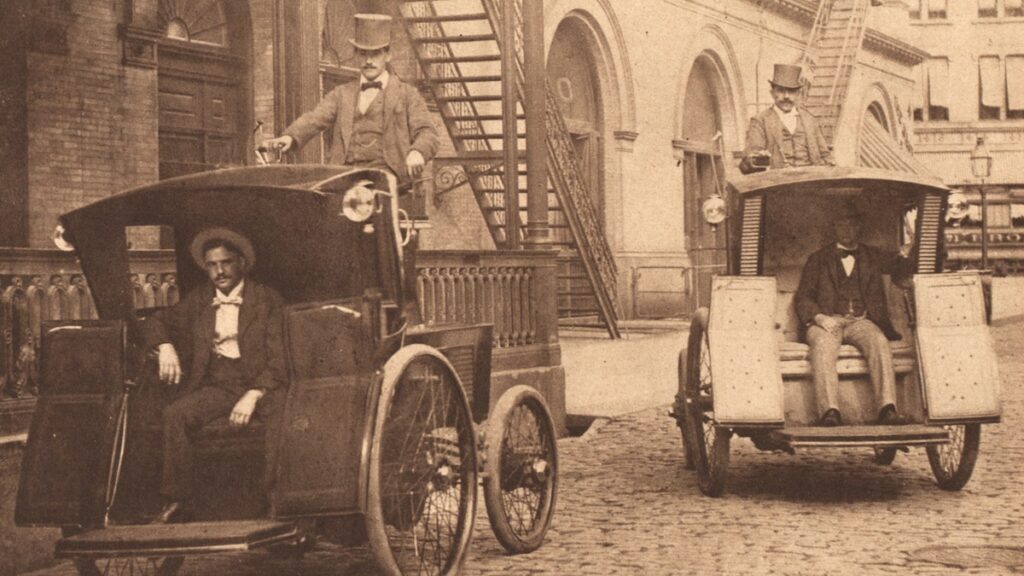The bustling streets of 19th-century Manhattan had a horse problem. The estimated 150,000 horses roaming the city each produced 22 pounds of waste daily.
The inauguration of New York City’s motorized taxicab service on March 27, 1897, promised a cleaner solution. Because Gotham’s first taxis weren’t powered by gasoline—but by electricity. It turns out that the car of the future is actually from the past.
An electric start
The idea of electric vehicles gliding around New York City in the 1890s might sound like a steampunk-inspired fever dream, but battery-powered automobiles outsold their internal combustion counterparts at the dawn of the automotive age. Electric cars were quiet, clean, and easy to drive. “Back then, you were lucky if a gas car started in the morning,” says Dan Albert, author of Are We There Yet? The American Automobile Past, Present, and Driverless. “It was noisy, polluting, and rickety, whereas an electric car started with a flip of the switch.”
During the 19th century, when electricity began to be used practically, it seemed capable of overcoming any challenge. “If you asked people on the street what was going to happen, they would have said that electricity is this magic force,” says electric car historian David A. Kirsch, author of The Electric Vehicle and the Burden of History. “We harnessed it for light. We harnessed it for traction through the trolley. It’s spreading everywhere, and now it’s going to take us around.”
The pioneering Electrobat
When Nikola Tesla was the only Tesla making headlines, the Electrobat emerged as the first commercially viable electric vehicle. Crafted by Philadelphia engineers Henry Morris and Pedro Salom in 1894, this 2,500-pound car was propelled by a lead-acid battery, achieving top speeds of 15 miles per hour and covering distances of up to 25 miles on a single charge.
Furthermore, the pair devised an ingenious battery-swapping system inside a former Broadway roller skating rink to keep its cabs in continuous operation. Working with the efficiency of a NASCAR pit crew, employees maneuvered vehicles with elevators and hydraulics as an overhead crane, plucked out the depleted 1,000-pound batteries, and inserted fresh ones. The process took only three minutes. “It was much faster than changing a horse team and probably as fast as what we would today associate with filling a tank of gas,” Kirsch says.
The duo’s Manhattan cab service rapidly gained popularity, especially among the upper echelons of society. Rather than selling their cars, Morris and Salom opted to lease their vehicles on a monthly or per-ride basis through their venture, the Electric Wagon & Carriage Company.
The taxi fleet experienced substantial growth, expanding from a mere dozen vehicles in 1897 to over 100 by 1899. The Electrobat proved the ideal city car with its rapid acceleration and noiseless ride. However, its speed and quietness posed unforeseen challenges. In May 1899, the press reported that cab driver Jacob German had become the first automobile operator arrested for speeding after whizzing down Lexington Avenue at 12 miles per hour. Weeks later, an electric taxi fatally struck real estate broker Henry Bliss as he stepped off an Upper West Side streetcar. The first pedestrian killed by an automobile never heard the Electrobat coming.
The bubble bursts
Morris and Salom found new backing from wealthy investors, notably New York financier William Whitney, known for his success in electrifying the city’s streetcars. Under Whitney’s leadership, the company merged with the electric street railways and battery manufacturing firms to form an integrated, nationwide electric transportation network.
The Electric Vehicle Company swiftly expanded its taxi operations to major cities like Philadelphia, Chicago, and Boston, eventually becoming the nation’s largest automobile manufacturer. However, its rapid expansion proved unsustainable. Operations outside New York were poorly run, and investors felt swindled when a New York Herald investigation in late 1899 revealed the Electric Vehicle Company had fraudulently secured a loan. The company’s stock plummeted, and the enterprise was virtually bankrupt by 1902.
Electric cars lose power
The company’s collapse sent shockwaves through the investment community and cast a shadow over the future of electric vehicles.
“The thing that killed it is not really the idea, the technology, or the business model,” Albert says. “It was the shadiness of the wheeler-dealers behind it.”
A devastating fire destroyed a significant portion of the fleet. Coupled with the economic turmoil of the Panic of 1907, this dealt a final blow to electric cabs in New York City just as gasoline-powered vehicles gained momentum in the market. The same year, local businessman Harry Allen introduced a taxi service with 65 gasoline-powered cabs imported from France. Within a year, his fleet swelled to 700 vehicles.
The internal combustion engine would drive the next American century, but battery power is slowly returning after a long detour. When 25 all-electric taxis began operation on the streets of New York in 2022, the car of the future arrived—again.
>>> Read full article>>>
Copyright for syndicated content belongs to the linked Source : National Geographic – https://www.nationalgeographic.com/history/article/history-of-new-yorks-19th-century-electric-cabs
